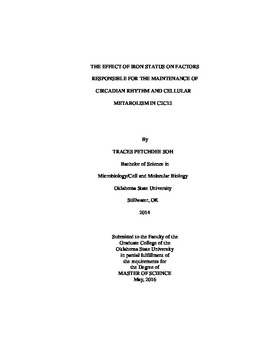| dc.contributor.advisor | Clarke, Stephen L. | |
| dc.contributor.author | Soh, Traces Petchdee | |
| dc.date.accessioned | 2019-08-19T16:58:30Z | |
| dc.date.available | 2019-08-19T16:58:30Z | |
| dc.date.issued | 2016-05-01 | |
| dc.identifier.uri | https://hdl.handle.net/11244/321171 | |
| dc.description.abstract | In mammals iron deficiency (ID) may contribute to hyperglycemia and dyslipidemia. Similar changes in glucose and lipid metabolism are observed in response to abnormalities in circadian rhythm. The nuclear hormone receptors (NHR) REV-ERBα and REV-ERBβ are heme-regulated transcription factors that are critical to the maintenance of circadian rhythm [1], [2]. Cellular oscillations in circadian rhythm are controlled through a network of negative feedback and feed-forward loops that regulate the transcription of clock-related and metabolic genes. In the presence of heme, REV-ERBs repress transcription of Bmal1, G6pase, and Pepck in the liver and reduced heme levels leads to de-repression of these genes [3]. In skeletal muscle, targets of REV-ERBs such as Bmal1 regulate the transcription of MyoD, Pgc-1α and Pgc-1β, proteins that are involved in cellular differentiation and metabolic function [4]. Bmal1 expression is also controlled by another NHR, RORα which activates the transcription of Bmal1. Expression profiling in skeletal muscle of clock mutant mice showed that skeletal muscle specific gene expression MyoD and Pdk4, which are important for cell proliferation and glucose metabolism, were dyregulated. The aim of the study was to investigate the effect of iron status on the regulation of circadian rhythm and cellular metabolism in C2C12 myoblast and myotubes. C2C12 myoblasts and myotubes were treated with the iron chelator desferroxamine (DFO) or iron in the form of ferric ammonium citrate (FAC) or hemin. RNA was extracted for gene expression analyses. Rhythmicity in circadian genes was altered by iron chelation and iron loading in C2C12 myoblasts and myotubes. Iron chelation decreased iron availability for heme biosynthesis resulting in a de-repression of REV-ERBα activity and transactivation of Bmal1 gene expression in both myotubes and myoblasts. These findings are consistent with studies in ID animals. Low cellular iron status may potentially dysregulate CLOCK:BMAL modulations of its target gene (MyoD , Pgc-1α and Pgc-1β). Bmal1 and Tfrc response to a decrease in iron status in both C2C12 myoblasts and myotubes and are similar to observations in the skeletal muscle of ID animals. Additional studies may be required to understand the mechanisms that altered these circadian and metabolic gene expression. | |
| dc.format | application/pdf | |
| dc.language | en_US | |
| dc.rights | Copyright is held by the author who has granted the Oklahoma State University Library the non-exclusive right to share this material in its institutional repository. Contact Digital Library Services at lib-dls@okstate.edu or 405-744-9161 for the permission policy on the use, reproduction or distribution of this material. | |
| dc.title | Effect of Iron Status on Factors Responsible for the Maintenance of Circadian Rhythm and Cellular Metabolism in C2C12 | |
| dc.contributor.committeeMember | Smith, Brenda J. | |
| dc.contributor.committeeMember | Lin, Dingbo | |
| osu.filename | Soh_okstate_0664M_14581.pdf | |
| osu.accesstype | Open Access | |
| dc.description.department | Nutritional Sciences | |
| dc.type.genre | Thesis | |
| dc.type.material | Text | |
